Voices from the Archives
Japanese American Internment, 1942–1946
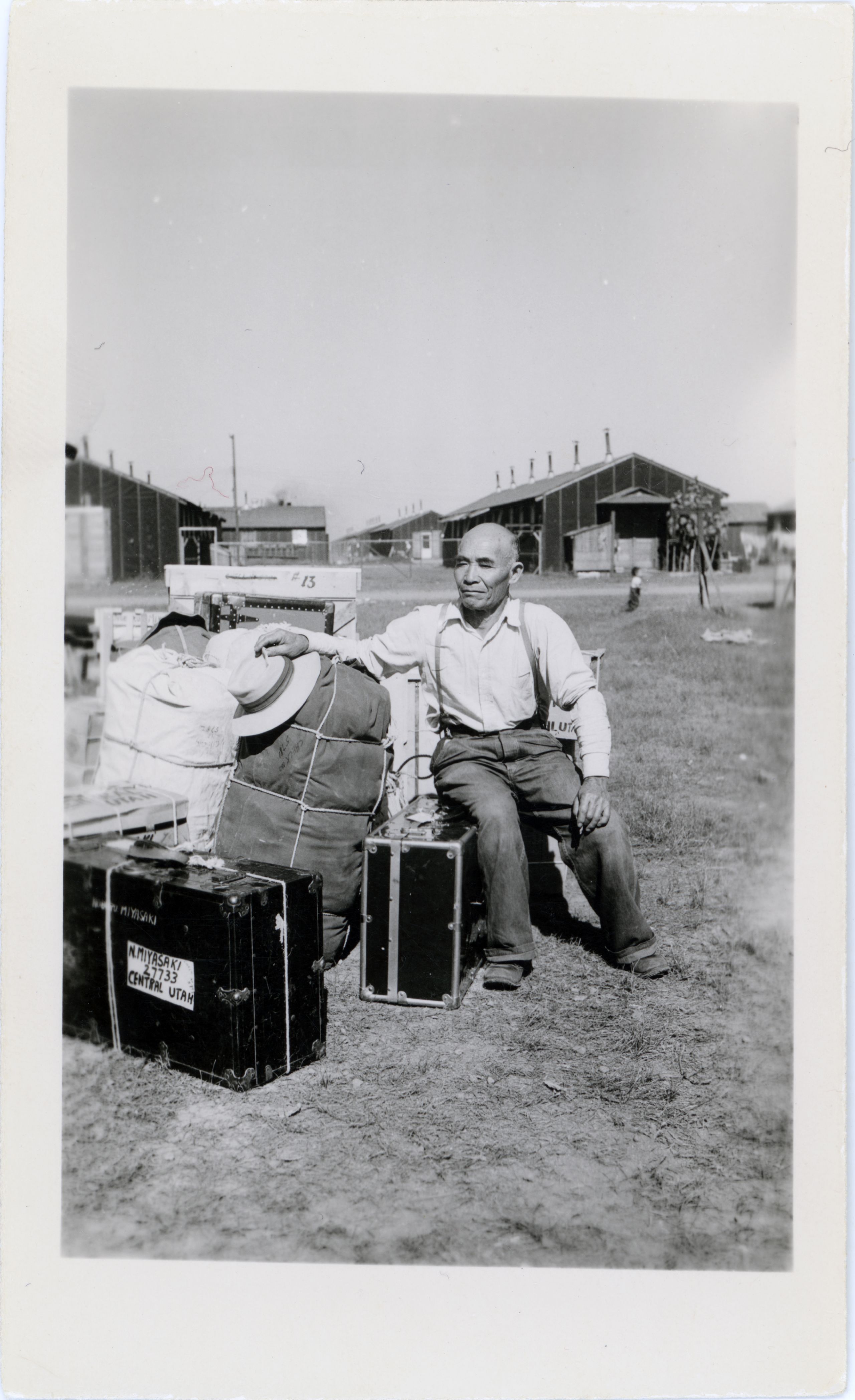
A note on language.
Language shapes the way we think and impacts our understanding of history. The familiar vocabulary of America during World War II is recognized today as misleading when describing what actually happened to Japanese Americans at the time. Euphemistic terms, such as assembly centers, evacuation, and relocation, were deliberately used to make government actions seem benign and acceptable during wartime. However deceptive these words are, they are the terms used in the primary source documents presented in the following digital story. To avoid confusion, the historic terminology is used as it appears in the documentation of the era presented here. Guidance on accurate terminology can be found in the following link: Power of Words Handbook

Executive Order 9066
E. O. 9066 was signed by President Franklin D. Roosevelt on February 19, 1942—two months after the Japanese attack on Pearl Harbor and America’s entry into World War II. It laid the foundation for the United States to deem the West Coast a Military Exclusion Zone, from which perceived dangers to national security could be legally removed. Their justification to deny personal liberty to American citizens and foreign aliens alike was declared “military necessity.”
Regardless of birthplace, education, or class, all persons of Japanese ancestry—roughly 120,000 —were systematically removed from this area and placed in local assembly centers before being transferred to War Relocation Authority (WRA) internment camps.
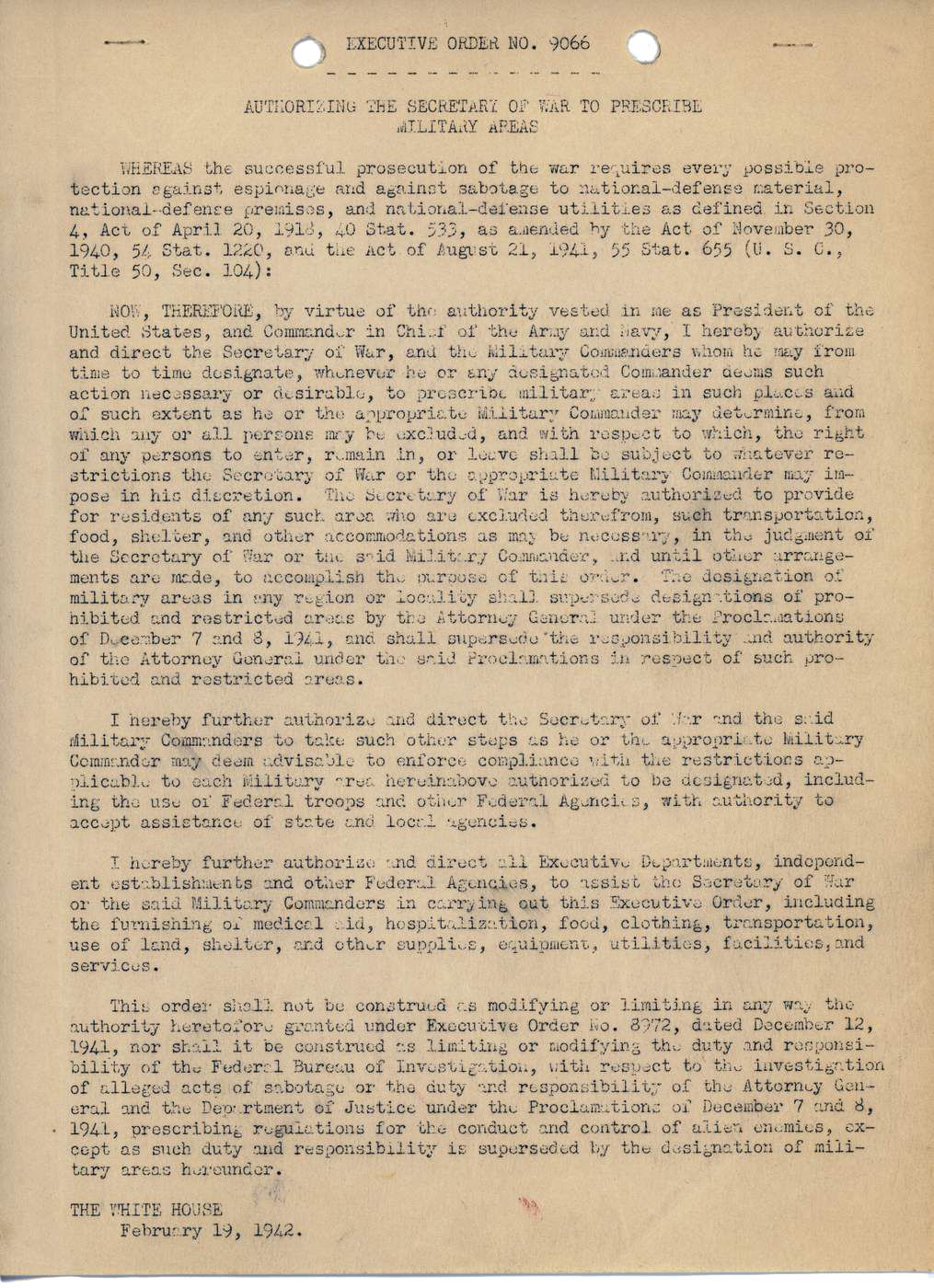
Executive Order No. 9066. Karl R. Bendetsen Papers, Hoover Institution Archives

Instructions to All Persons of Japanese Ancestry (for the City and County of San Francisco), April 1942. Karl R. Bendetsen Papers, Hoover Institution Archives
Instructions to All Persons of Japanese Ancestry (for the City and County of San Francisco), April 1942. Karl R. Bendetsen Papers, Hoover Institution Archives

Executive Order No. 9066. Karl R. Bendetsen Papers, Hoover Institution Archives
Executive Order No. 9066. Karl R. Bendetsen Papers, Hoover Institution Archives
Evacuation to Relocation
With the forced removal of people beginning in March 1942, there was little time to build accommodations for them. Assembly centers were often fairgrounds or racetracks, with every bit of space—even unclean horse stalls—being used as housing. The ten custom-built WRA camps were little better, with bare wooden structures covered in tar paper hastily set up in desolate areas.
Morale was understandably low in general among the Japanese Americans, though initially there was a common feeling of patriotism in their sacrifice. Younger generations were more positive, as schools at the camps created a sense of normalcy and gave them the chance to relocate out of camp and build new lives at a university or at work. Those who had spent decades working in America to provide for their families, building homes and successful careers, however, faced the stark reality that they would never return to what they once had.


Architect of Internment?
Many people advised President Roosevelt on the matter of internment; afterward even more were left to craft action plans and conduct the actual evacuations and relocations. A lynch pin in this work was Colonel Karl R. Bendetsen, a Stanford alumnus whose papers are housed in the Hoover Archives. A clear summary of Bendetsen’s reasoning for internment—focusing on sabotage, espionage and fifth-column activities—is articulated in his address “The Story of Pacific Coast Japanese Evacuation.”
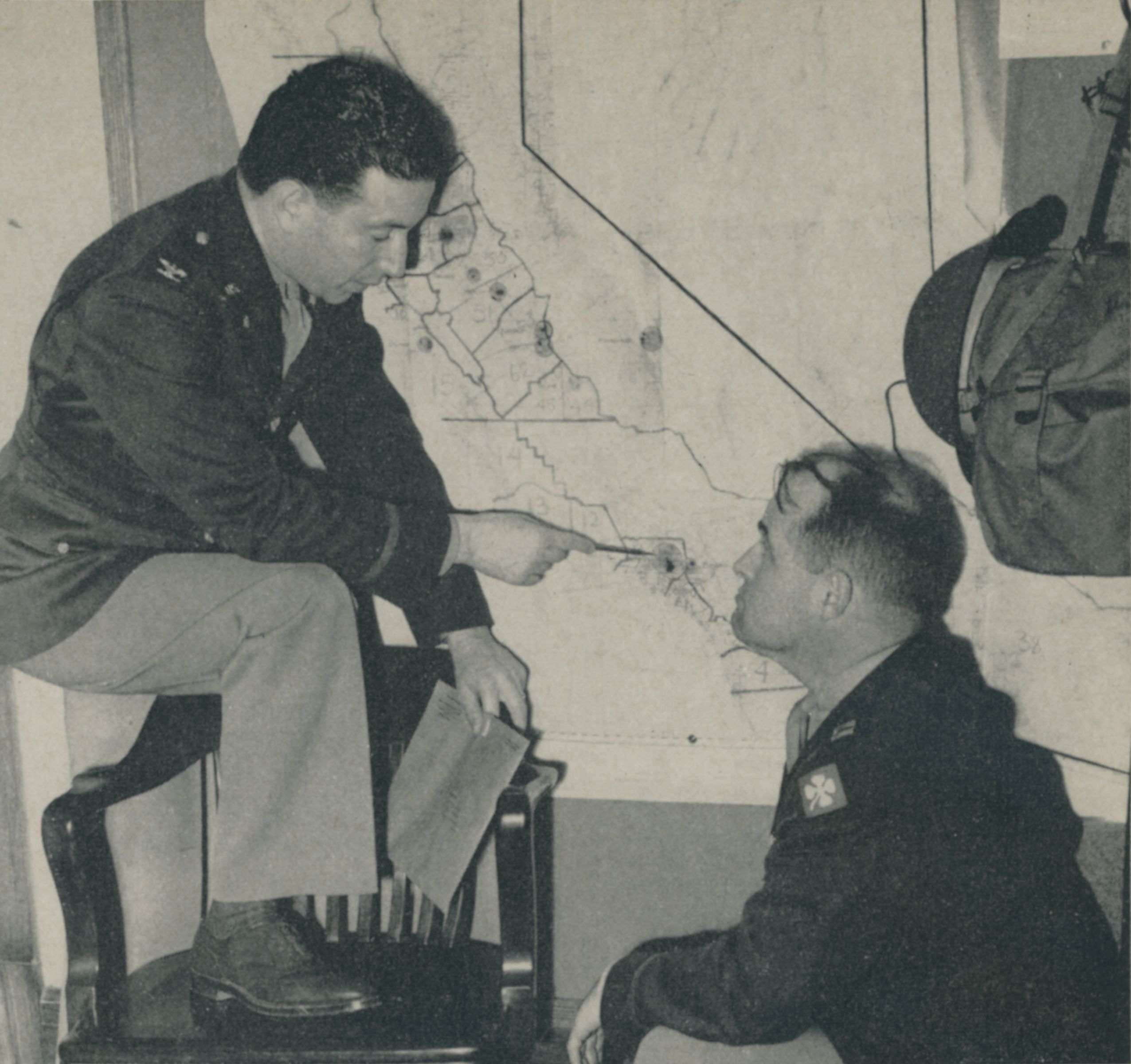
Col. Karl R. Bendetsen (left), head of General DeWitt’s Civil Affairs Division, shown at map of the Pacific Coast areas from which Japanese have been evacuated under his direction, 1942. Karl R. Bendetsen Papers, Hoover Institution Archives

The Story of Pacific Coast Japanese Evacuation, 1942. Karl R. Bendetsen Papers, Hoover Institution Archives
The Story of Pacific Coast Japanese Evacuation, 1942. Karl R. Bendetsen Papers, Hoover Institution Archives

Col. Karl R. Bendetsen (left), head of General DeWitt’s Civil Affairs Division, shown at map of the Pacific Coast areas from which Japanese have been evacuated under his direction, 1942. Karl R. Bendetsen Papers, Hoover Institution Archives
Col. Karl R. Bendetsen (left), head of General DeWitt’s Civil Affairs Division, shown at map of the Pacific Coast areas from which Japanese have been evacuated under his direction, 1942. Karl R. Bendetsen Papers, Hoover Institution Archives
Photographic Records

“The Photographic Section is maintained by the Government for documentary purposes only.”
Photography of the internment process, facilities, and daily life was largely regulated by the government. Select photographers, such as Dorothea Lange and Ansel Adams, were hired to document the evacuation and relocation projects; personal cameras were forbidden to internees. Regardless of the photographer’s wishes, all WRA photographs went through centralized processing where there was strict control over captioning and distribution—ensuring that mainly anonymous smiling faces were shown publicly.
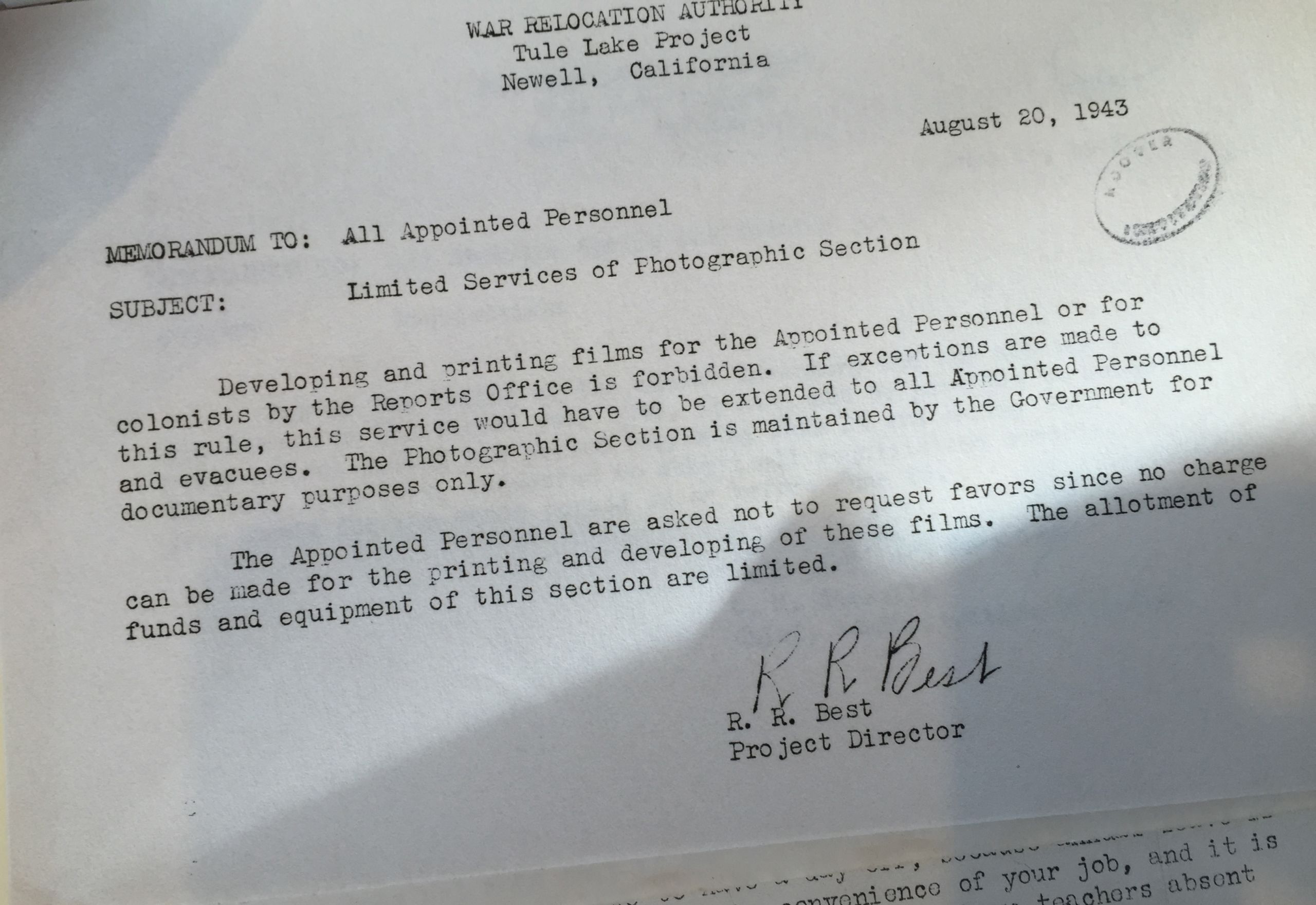
Memorandum from R. R. Best, Tule Lake Project Director, August 20, 1943. Karl R. Bendetsen Papers, Hoover Institution Archives

Challenge to Democracy flyer, 1944. Joseph Conard and Josephine Whitney Duveneck Collection, Hoover Institution Archives
The documentary film A Challenge to Democracy was one of many WRA promotional pieces intended to highlight the success of relocation and improve public perceptions of Japanese Americans for their eventual reintegration into society. The front cover shows seventy-year-old Sakutaro Aso and his grandson Shigeo Jerry Aso waiting to be deported from Hayward, California, in 1942. The back cover shows Hisako Hibi with her children Ibuki and Satoshi also waiting in Hayward to go to Tanforan Assembly Center.
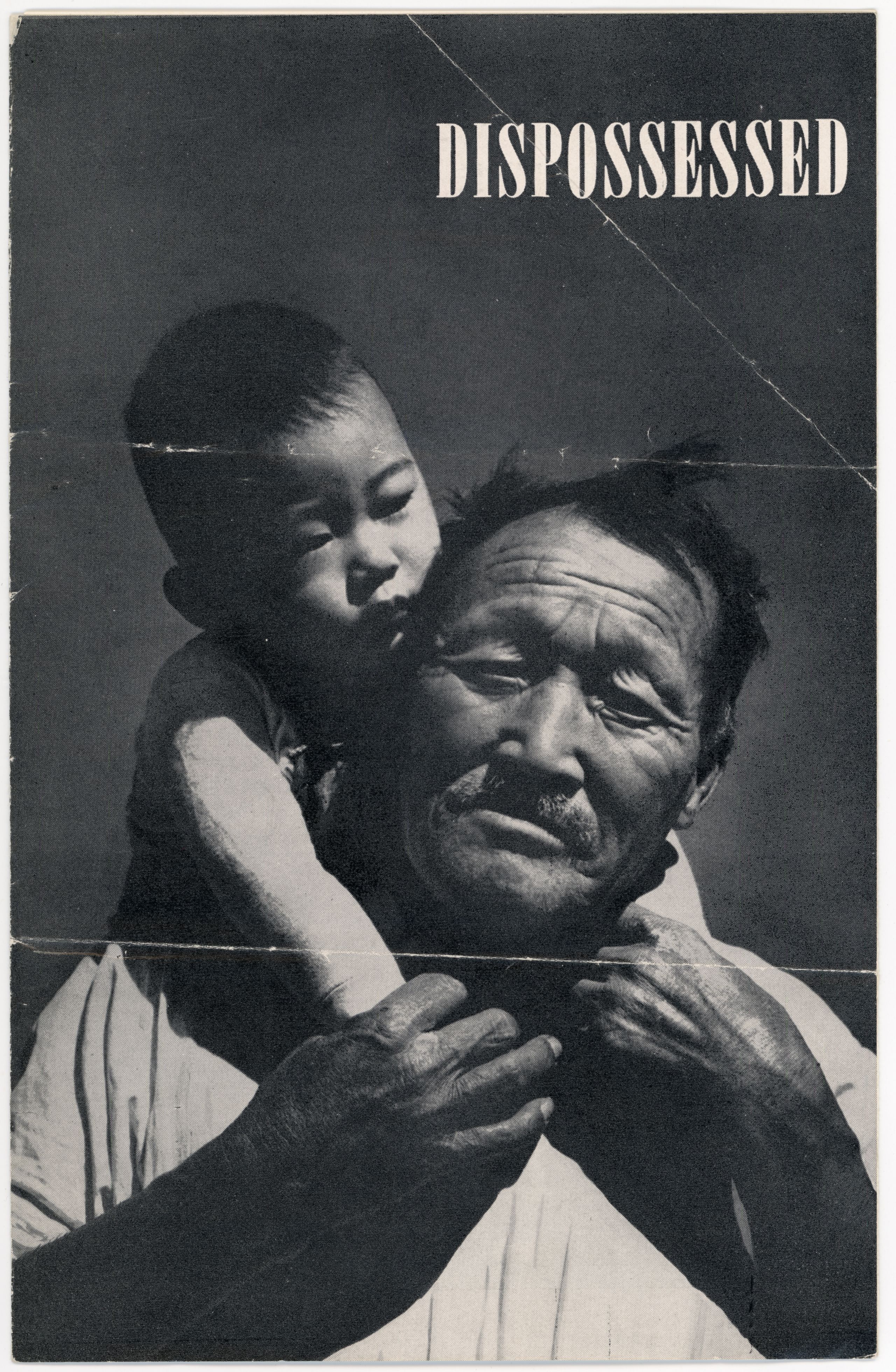
Dispossessed. Grace Nichols Pearson Papers, Hoover Institution Archives.
Dispossessed was published by the American Friends Service Committee circa 1943–44. The cover photograph of a grandfather and grandson was taken by Dorothea Lange in 1942 for the WRA at Manzanar, California. With no personal identification, the pictured internees anonymously gaze at viewers whom the publishers hoped would donate goods to help improve the lives of those interned.
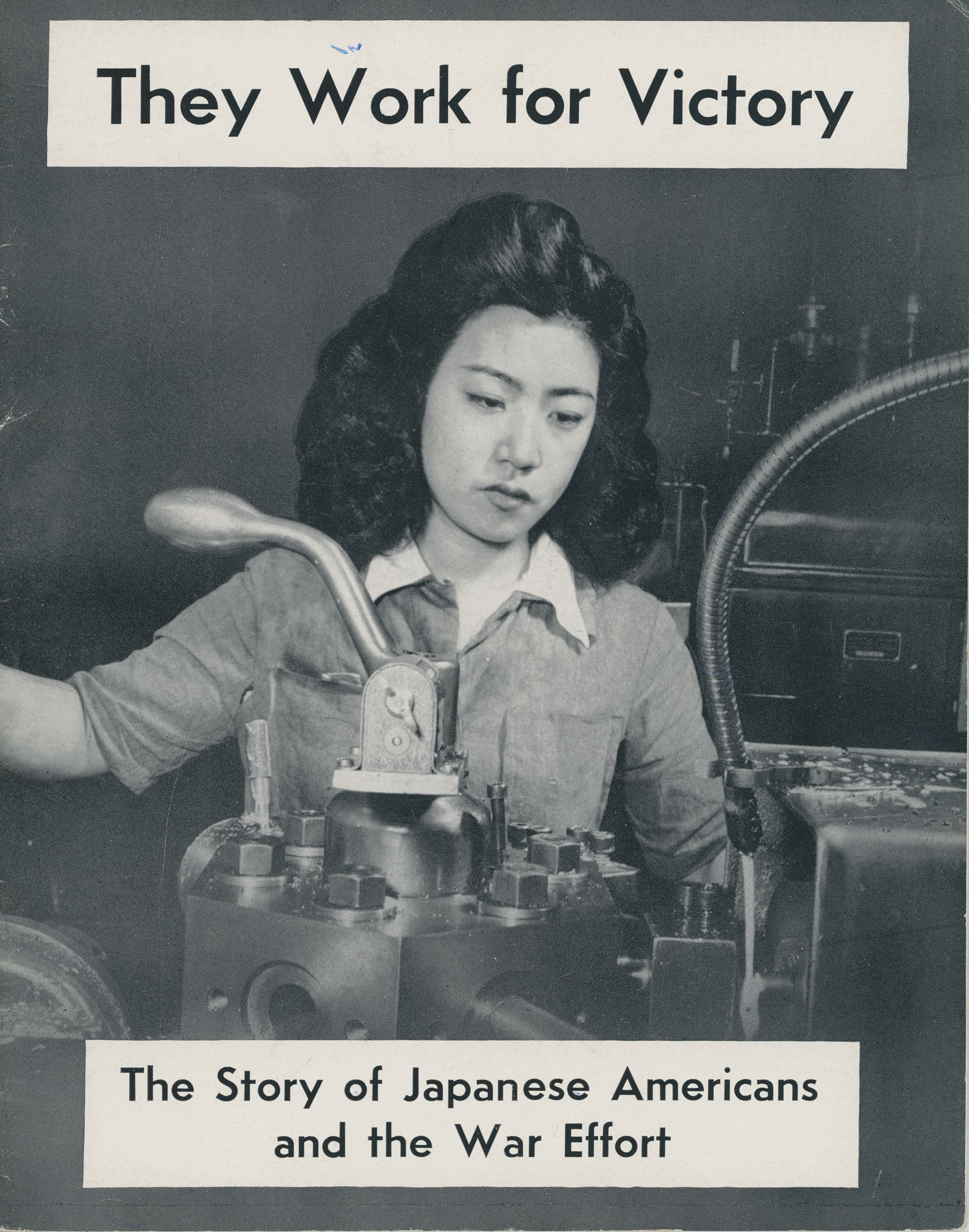
They Work for Victory, 1944. Frank B. and Josephine Whitney Duveneck Collection, Hoover Institution Archives.
They Work for Victory, The Story of Japanese Americans and the War Effort is a pamphlet produced by the WRA in 1944, with a cover photograph taken by Tom Parker. Highlighting the WRA efforts to reintegrate relocated Japanese Americans into society, the cover features Ruth Nishi, a twenty-one-year-old operating a turret lathe to make parts for gas valves for the Bloomfield Mfg. Co. in August 1943. Originally from Berkeley, Nishi had been sent to the Poston Camp in Arizona before relocating to Chicago.

Memorandum from R. R. Best, Tule Lake Project Director, August 20, 1943. Karl R. Bendetsen Papers, Hoover Institution Archives
Memorandum from R. R. Best, Tule Lake Project Director, August 20, 1943. Karl R. Bendetsen Papers, Hoover Institution Archives

Challenge to Democracy flyer, 1944. Joseph Conard and Josephine Whitney Duveneck Collection, Hoover Institution Archives
Challenge to Democracy flyer, 1944. Joseph Conard and Josephine Whitney Duveneck Collection, Hoover Institution Archives

Dispossessed. Grace Nichols Pearson Papers, Hoover Institution Archives.
Dispossessed. Grace Nichols Pearson Papers, Hoover Institution Archives.

They Work for Victory, 1944. Frank B. and Josephine Whitney Duveneck Collection, Hoover Institution Archives.
They Work for Victory, 1944. Frank B. and Josephine Whitney Duveneck Collection, Hoover Institution Archives.
Family Stories

Azeka, Gotanda, Horiuchi Families
Taketaro Azeka—a barber by trade, but a poet and artist by practice—was the patriarch of the Azeka, Gotanda, and Horiuchi families. With far more trunks than they could carry, the families entrusted their possessions to their friends the Von Blon family. The letters from Azeka and his daughters to the Von Blons reveal camp life vividly; a reference letter Mrs. Von Blon wrote on behalf of Azeka’s daughter, Shizuko Horiuchi, reflects the difficult procedures required to regain some individual freedom.
“I Wish Free My Life.”

Drawing of Pomona Assembly Center by Taketaro Azeka, 1942. Henriette B. Von Blon Papers, Hoover Institution Archives

Letter by Taketaro Azeka to the Von Blon family, September 7, 1942. Henriette B. Von Blon Papers, Hoover Institution Archives
Letter by Taketaro Azeka to the Von Blon family, September 7, 1942. Henriette B. Von Blon Papers, Hoover Institution Archives

Azeka's Garden #1 in Pomona Camp, by Taketaro Azeka at Pomona Assembly Center, August 10, 1942. Henriette B. Von Blon Papers, Hoover Institution Archives

Letter from Shizuko Horiuchi to Mrs. Von Blon, January 24, 1943. Henriette B. Von Blon Papers, Hoover Institution Archives
Letter from Shizuko Horiuchi to Mrs. Von Blon, January 24, 1943. Henriette B. Von Blon Papers, Hoover Institution Archives
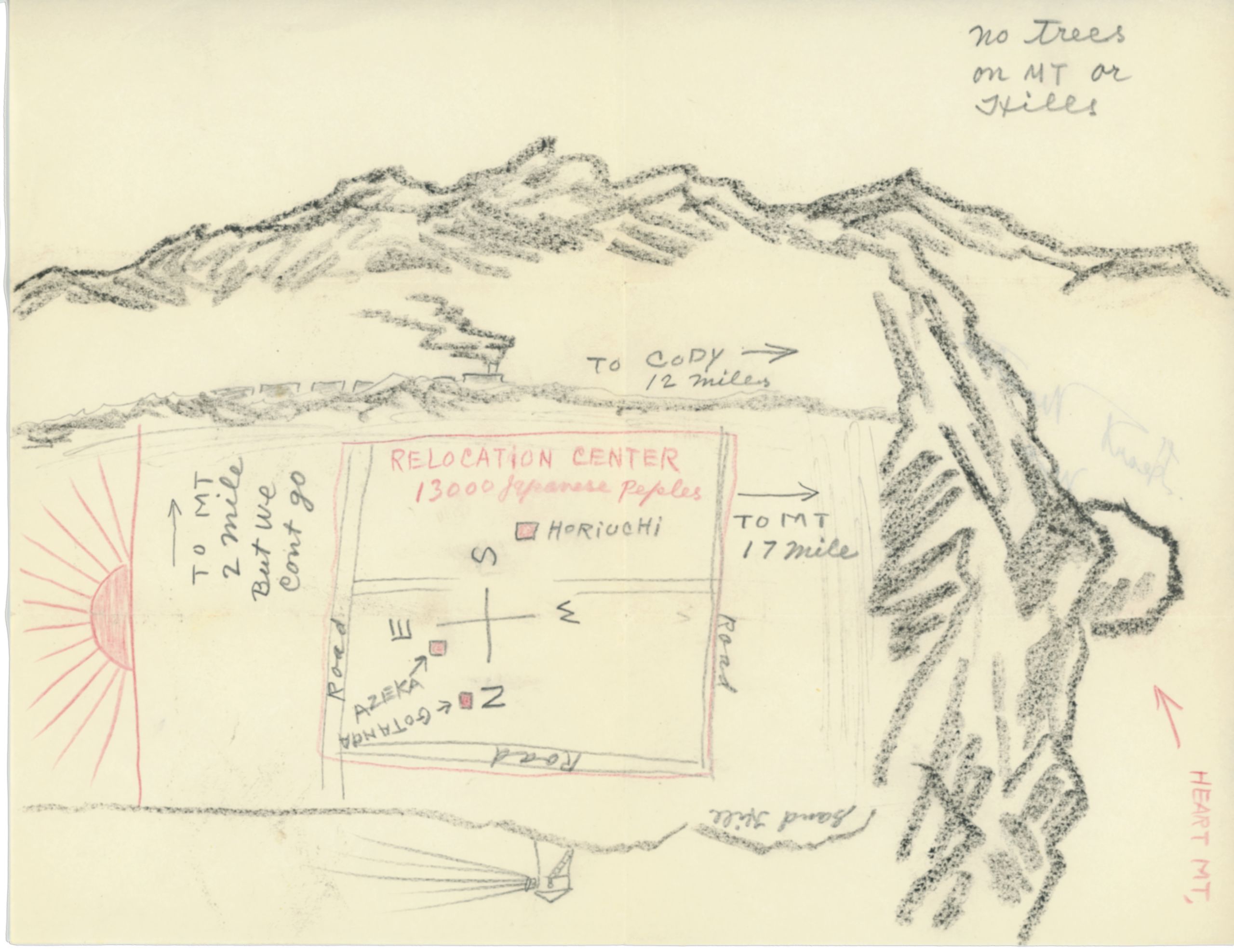
Heart Mountain Relocation Center drawing, by Taketaro Azeka, 1942. Henriette B. Von Blon Papers, Hoover Institution Archives
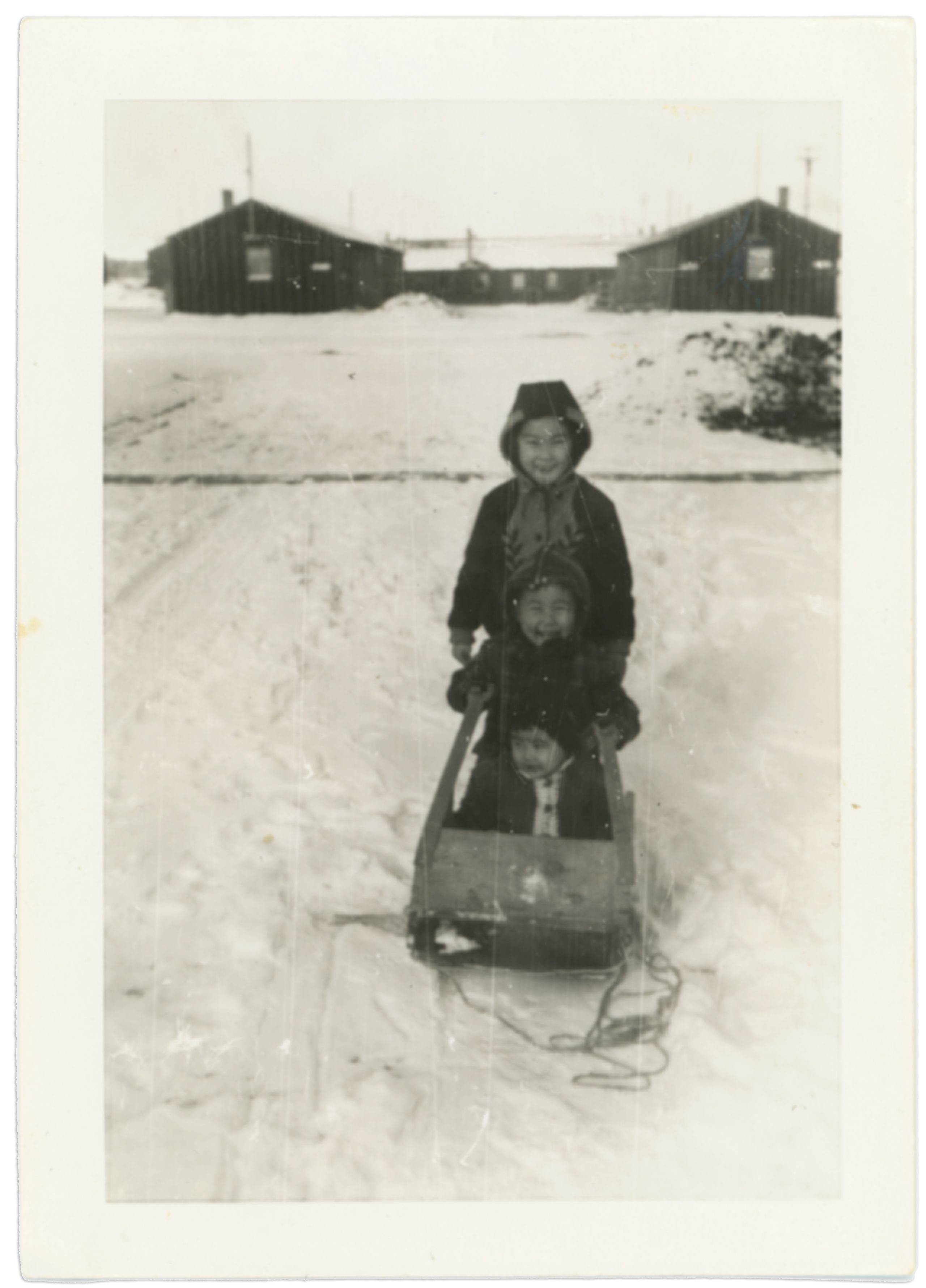
Shizuko Horiuchi's children at Heart Mountain Camp, January 1943. Henriette B. Von Blon Papers, Hoover Institution Archives

Reference Request from the WRA to Mrs. Von Blon for Shizuko Horiuchi (with Mrs. Von Blon's draft response written on bottom, starting on the back of the page), February 19, 1943. Henriette B. Von Blon Papers, Hoover Institution Archives
Reference Request from the WRA to Mrs. Von Blon for Shizuko Horiuchi (with Mrs. Von Blon's draft response written on bottom, starting on the back of the page), February 19, 1943. Henriette B. Von Blon Papers, Hoover Institution Archives
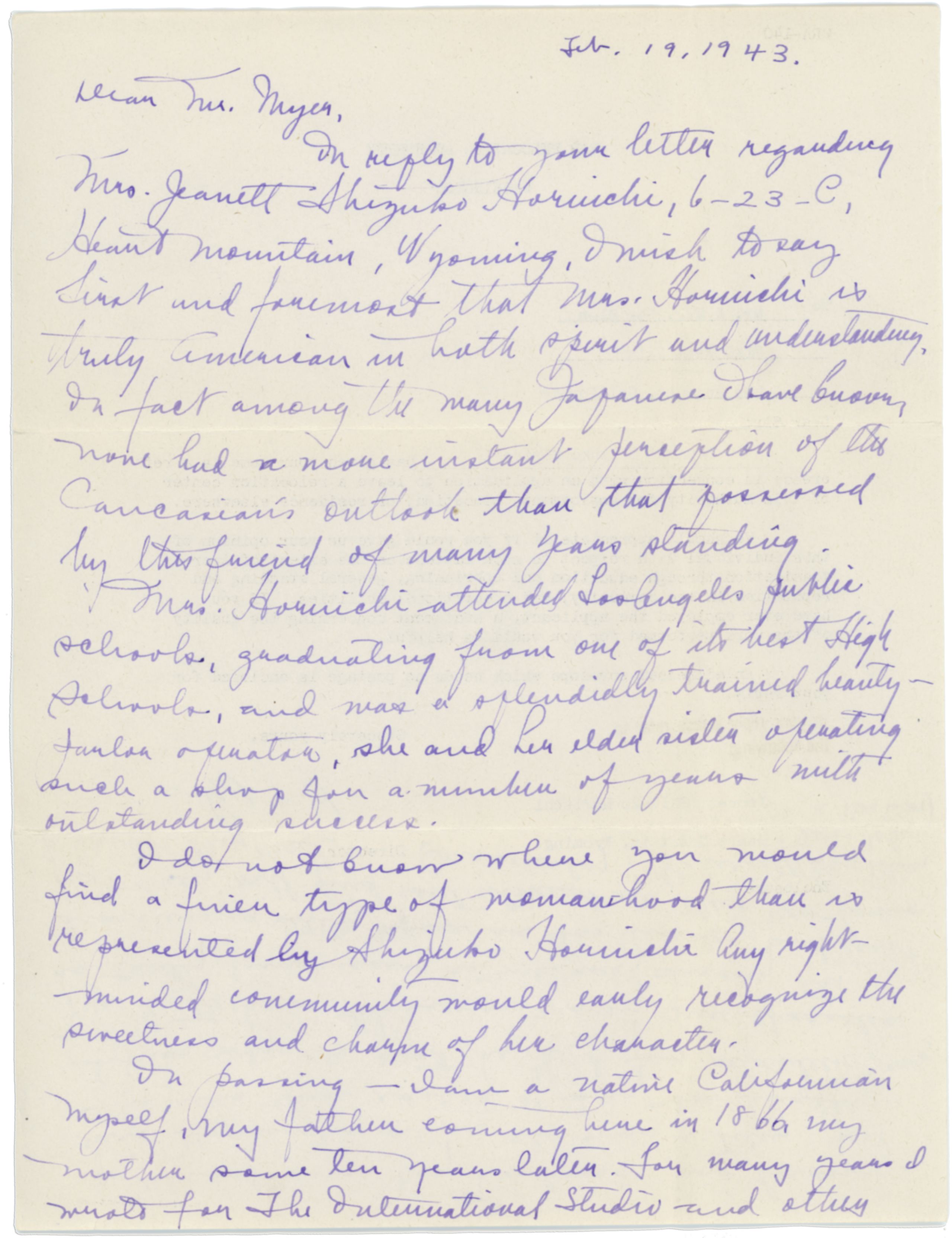
Back side of Reference Request with draft letter, written by Mrs. Von Blon, Feb. 19, 1943. Henriette B. Von Blon Papers, Hoover Institution Archives

Drawing of Pomona Assembly Center by Taketaro Azeka, 1942. Henriette B. Von Blon Papers, Hoover Institution Archives
Drawing of Pomona Assembly Center by Taketaro Azeka, 1942. Henriette B. Von Blon Papers, Hoover Institution Archives

Azeka's Garden #1 in Pomona Camp, by Taketaro Azeka at Pomona Assembly Center, August 10, 1942. Henriette B. Von Blon Papers, Hoover Institution Archives
Azeka's Garden #1 in Pomona Camp, by Taketaro Azeka at Pomona Assembly Center, August 10, 1942. Henriette B. Von Blon Papers, Hoover Institution Archives

Heart Mountain Relocation Center drawing, by Taketaro Azeka, 1942. Henriette B. Von Blon Papers, Hoover Institution Archives
Heart Mountain Relocation Center drawing, by Taketaro Azeka, 1942. Henriette B. Von Blon Papers, Hoover Institution Archives

Shizuko Horiuchi's children at Heart Mountain Camp, January 1943. Henriette B. Von Blon Papers, Hoover Institution Archives
Shizuko Horiuchi's children at Heart Mountain Camp, January 1943. Henriette B. Von Blon Papers, Hoover Institution Archives

Back side of Reference Request with draft letter, written by Mrs. Von Blon, Feb. 19, 1943. Henriette B. Von Blon Papers, Hoover Institution Archives
Back side of Reference Request with draft letter, written by Mrs. Von Blon, Feb. 19, 1943. Henriette B. Von Blon Papers, Hoover Institution Archives

The Kumano Family
Chisato came to America in 1920 after marrying Takaji Kumano, who had emigrated in 1905. Although from a good family in Japan, with her little brother Yasamaru having been chosen as a playmate for Prince Akihito, Chisato and her family were evacuated from Palo Alto, eventually to find themselves in the Heart Mountain Relocation Camp in Wyoming.

The Kumano family at Heart Mountain Camp, 1943. Alice Newman Hays Papers, Hoover Institution Archives
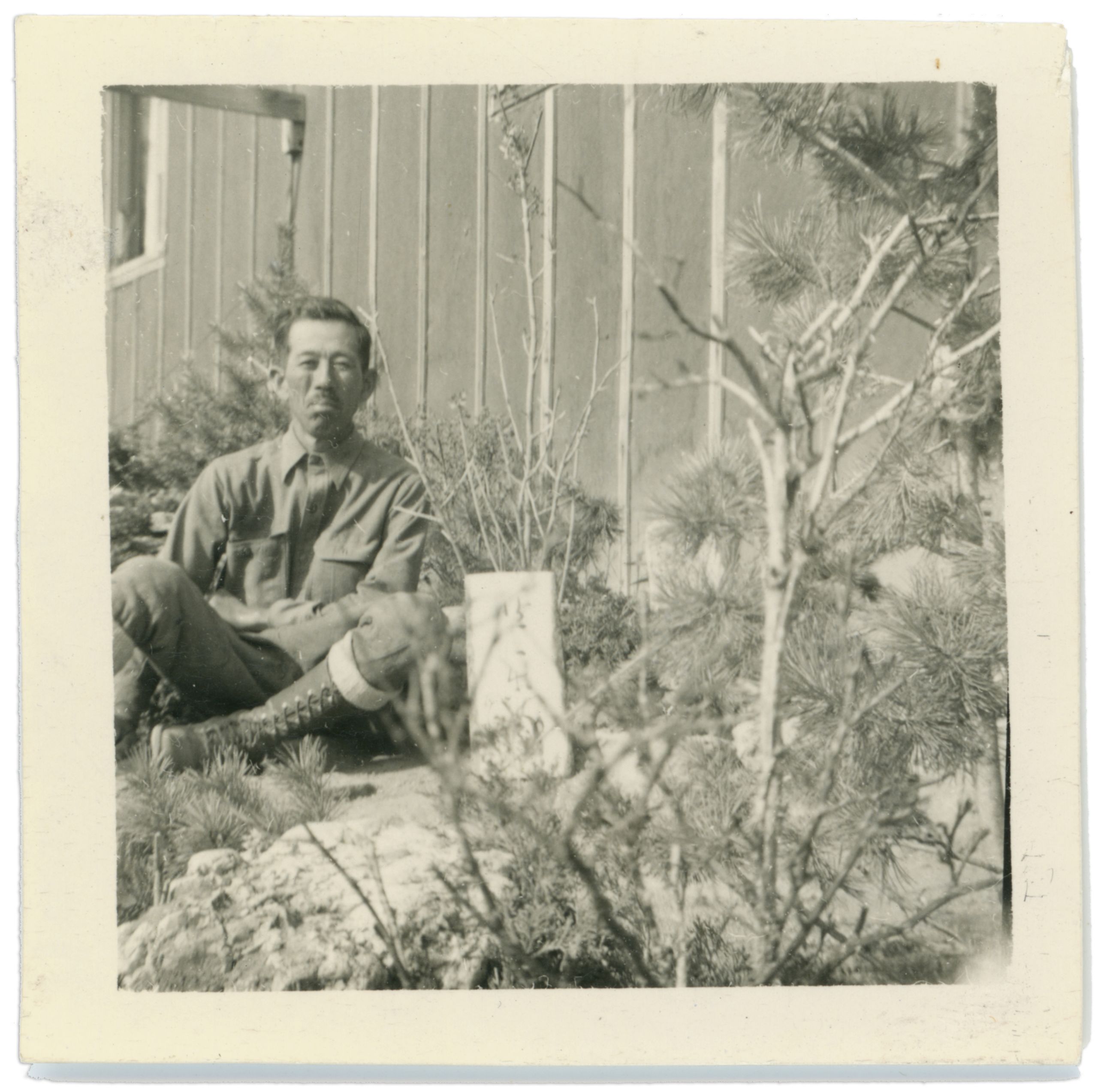
Mr. Kumano in his garden at Heart Mountain Camp, 1943. Alice Newman Hays Papers, Hoover Institution Archives
In this letter to her friend Miss Minna Stillman, a librarian at Stanford University, she shares her pride in her family—one son leaving camp for college and her husband’s gardening—as well as her strength in coping with the reality that word from her teenage son and brother in Japan arrived only sporadically.

Letter with photographs to Miss M. Stillman from Chisato Kumano, December 25, 1943. Alice Newman Hays Papers, Hoover Institution Archives
Letter with photographs to Miss M. Stillman from Chisato Kumano, December 25, 1943. Alice Newman Hays Papers, Hoover Institution Archives
Years later, Chisato’s brother, Admiral Yasamaru Taniguchi, visited her family in Palo Alto from Japan. On the reverse of this photograph of the Kumanos with Taniguchi, she inscribed this poem to him in Japanese:
“Feel blessed that we are still alive to see and talk on and on to each other. / Is this a dream? / Went out to spring garden with you (Yasumaru [sic]) to view the Japanese apricot blossoms and scenery. / We reminisced our childhood life as an older sister with my younger brother: / We both successfully crossed over the mountain."
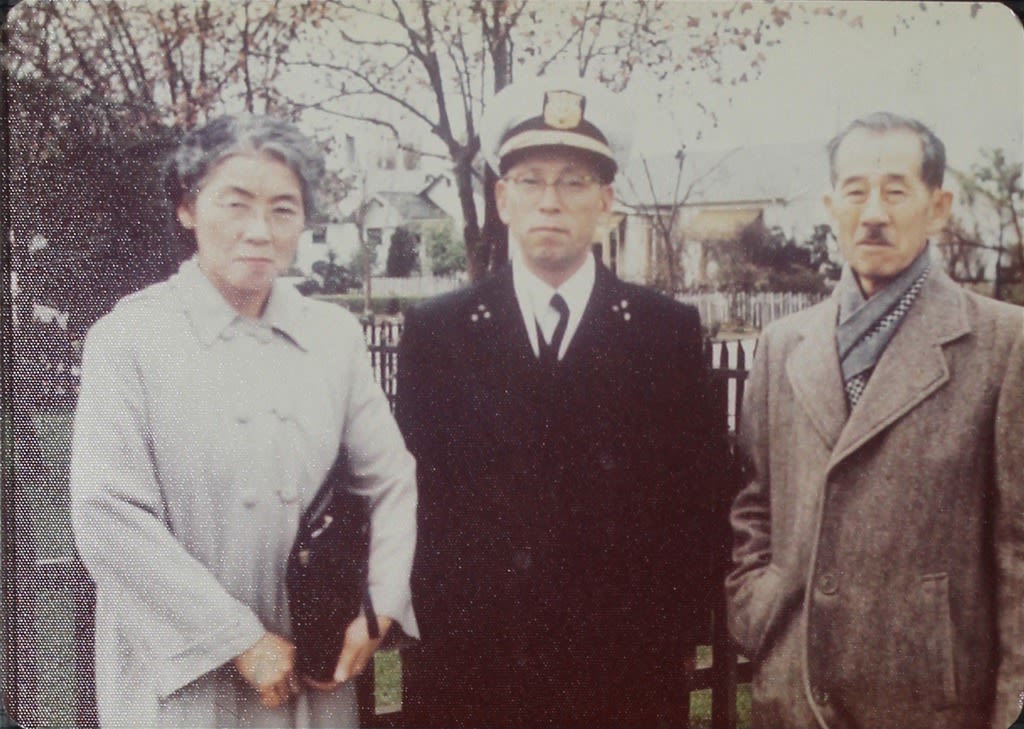
The Kumanos with Admiral Yasamaru Taniguchi at center, February 1960. Courtesy of the Taniguchi Family.

The Kumano family at Heart Mountain Camp, 1943. Alice Newman Hays Papers, Hoover Institution Archives
The Kumano family at Heart Mountain Camp, 1943. Alice Newman Hays Papers, Hoover Institution Archives

Mr. Kumano in his garden at Heart Mountain Camp, 1943. Alice Newman Hays Papers, Hoover Institution Archives
Mr. Kumano in his garden at Heart Mountain Camp, 1943. Alice Newman Hays Papers, Hoover Institution Archives

The Kumanos with Admiral Yasamaru Taniguchi at center, February 1960. Courtesy of the Taniguchi Family.
The Kumanos with Admiral Yasamaru Taniguchi at center, February 1960. Courtesy of the Taniguchi Family.

The Ono-Nagano Family
Born in California, Atsuko “Ann” Ono received her BA shortly before she and her parents were sent to the Fresno Assembly Center and later to the Jerome Relocation Center in Arkansas. But the harsh realities of camp life was not for her, and she was fortunately able to soon leave to attend the University of Michigan.
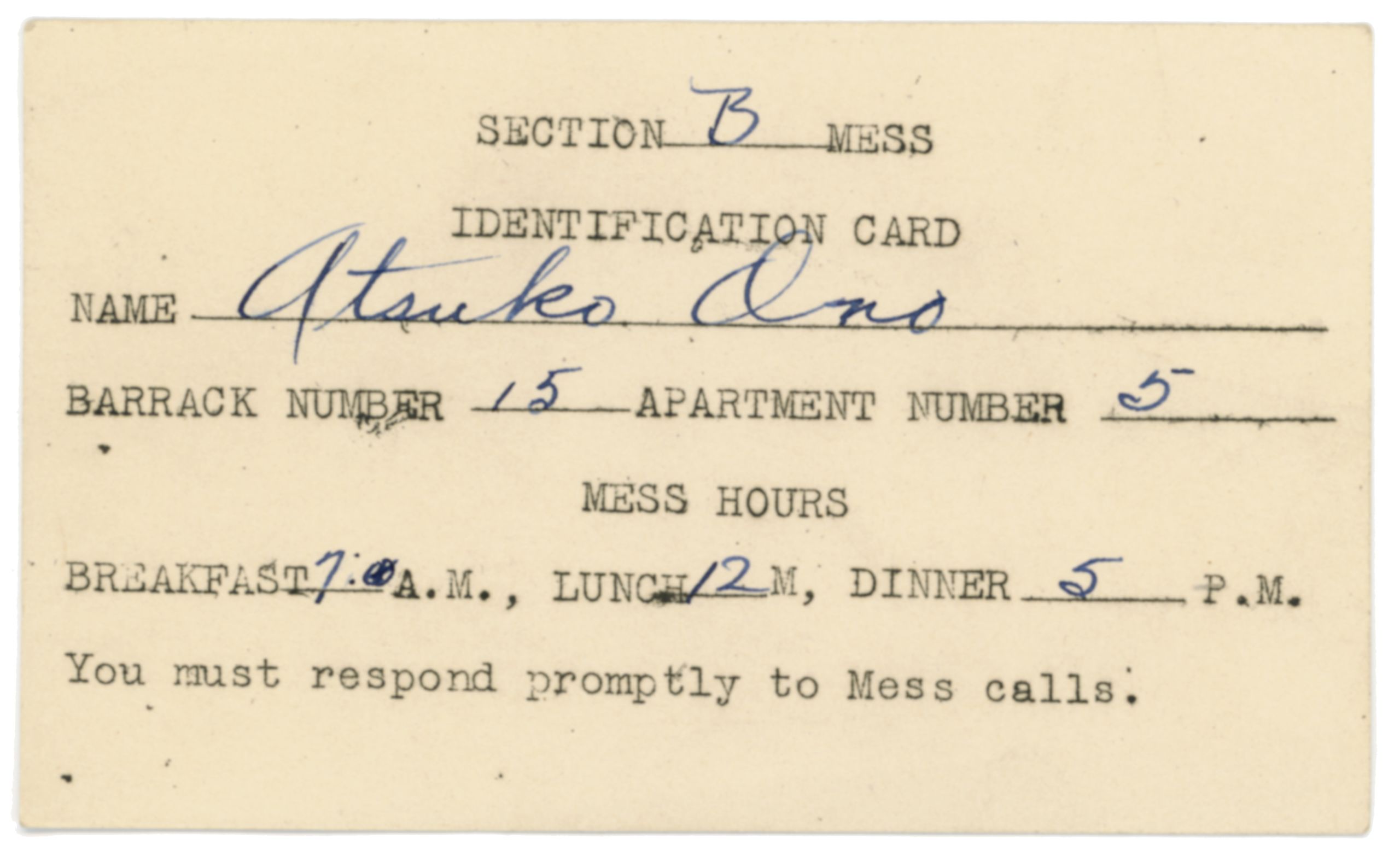
Atsuko Ono's Identification Card at Fresno Assembly Center, 1942. Margaret Cosgrave Sowers Papers, Hoover Institution Archives

An Information Bulletin given to the Ono family in preparation of moving to the Fresno Assembly Center in May 1942. Margaret Cosgrave Sowers Papers, Hoover Institution Archives
An Information Bulletin given to the Ono family in preparation of moving to the Fresno Assembly Center in May 1942. Margaret Cosgrave Sowers Papers, Hoover Institution Archives
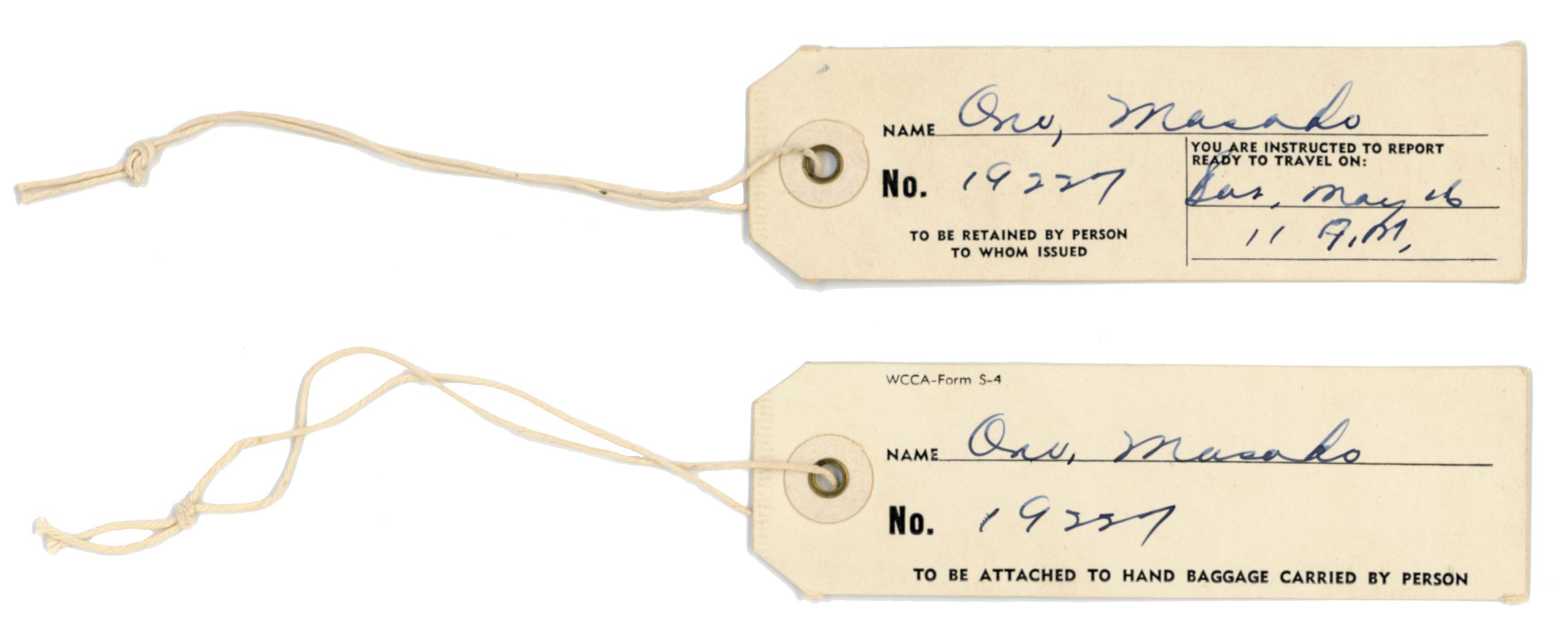
ID Tags assigned to Masako Ono (Atsuko's younger sister), 1942. Margaret Cosgrave Sowers Papers, Hoover Institution Archives. Masako also entered Fresno Assembly Center on May 16, 1942. By the fall she was a freshman attending Drake University in Iowa.
In Michigan Atsuko met Pat Nagano, a Stanford graduate who had escaped the Poston camp by joining Military Intelligence. They were soon married and had their daughter Karen at Fort Snelling, Minnesota, while their Japanese parents remained interned.
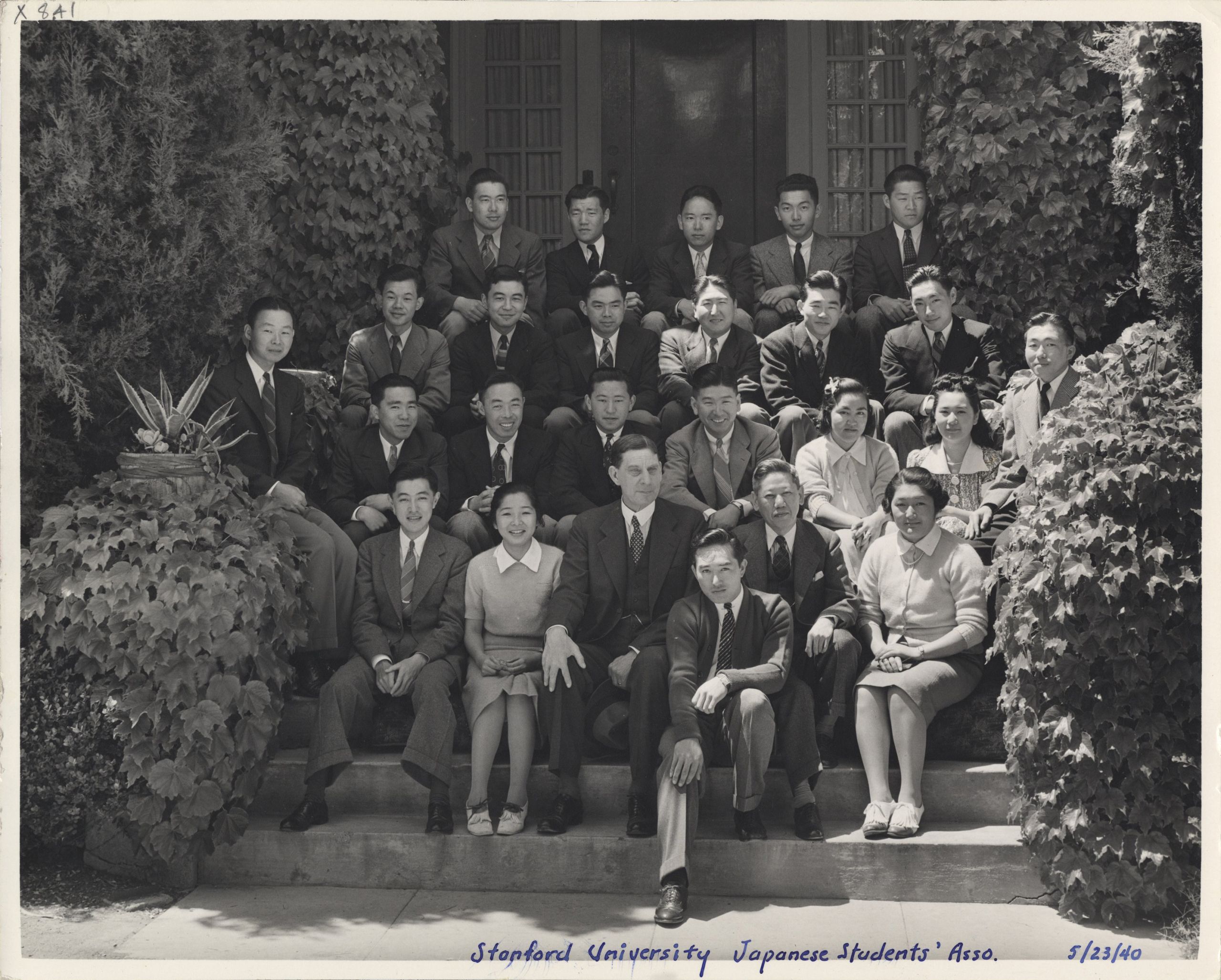
Pat Nagano (front and center), Japanese Students Association, Stanford University, by Berton Crandall, May 23, 1940. Stanford Historical Photograph Collection, Stanford University Libraries.

Atsuko and Pat Nagano with their baby Karen, 1943. San Luis Obispo Tribune (November 14, 2015).
Atsuko and Pat Nagano with their baby Karen, 1943. San Luis Obispo Tribune (November 14, 2015).

Atsuko Ono's Identification Card at Fresno Assembly Center, 1942. Margaret Cosgrave Sowers Papers, Hoover Institution Archives
Atsuko Ono's Identification Card at Fresno Assembly Center, 1942. Margaret Cosgrave Sowers Papers, Hoover Institution Archives

ID Tags assigned to Masako Ono (Atsuko's younger sister), 1942. Margaret Cosgrave Sowers Papers, Hoover Institution Archives. Masako also entered Fresno Assembly Center on May 16, 1942. By the fall she was a freshman attending Drake University in Iowa.
ID Tags assigned to Masako Ono (Atsuko's younger sister), 1942. Margaret Cosgrave Sowers Papers, Hoover Institution Archives. Masako also entered Fresno Assembly Center on May 16, 1942. By the fall she was a freshman attending Drake University in Iowa.

Pat Nagano (front and center), Japanese Students Association, Stanford University, by Berton Crandall, May 23, 1940. Stanford Historical Photograph Collection, Stanford University Libraries.
Pat Nagano (front and center), Japanese Students Association, Stanford University, by Berton Crandall, May 23, 1940. Stanford Historical Photograph Collection, Stanford University Libraries.
Documenting Internment

Newspaper Collections
After E.O. 9066, Japanese newspaper publishers in the affected areas temporarily closed down their businesses. The San Francisco-based Nichibei Shinbun, permitted by US authorities to publish after the outbreak of the war in order to disseminate government orders in the nikkei community, was the last major Japanese newspaper on the West Coast in operation.
When the publisher failed to obtain permission from authorities to continue publishing at a new location, the May 16, 1942, order to remove Japanese and Japanese Americans in San Francisco meant they had to announce their closure. The newspapers they issued up to that date can be read in the Hoji Shinbun Digital Collection, along with others produced by the Japanese diaspora at the time.
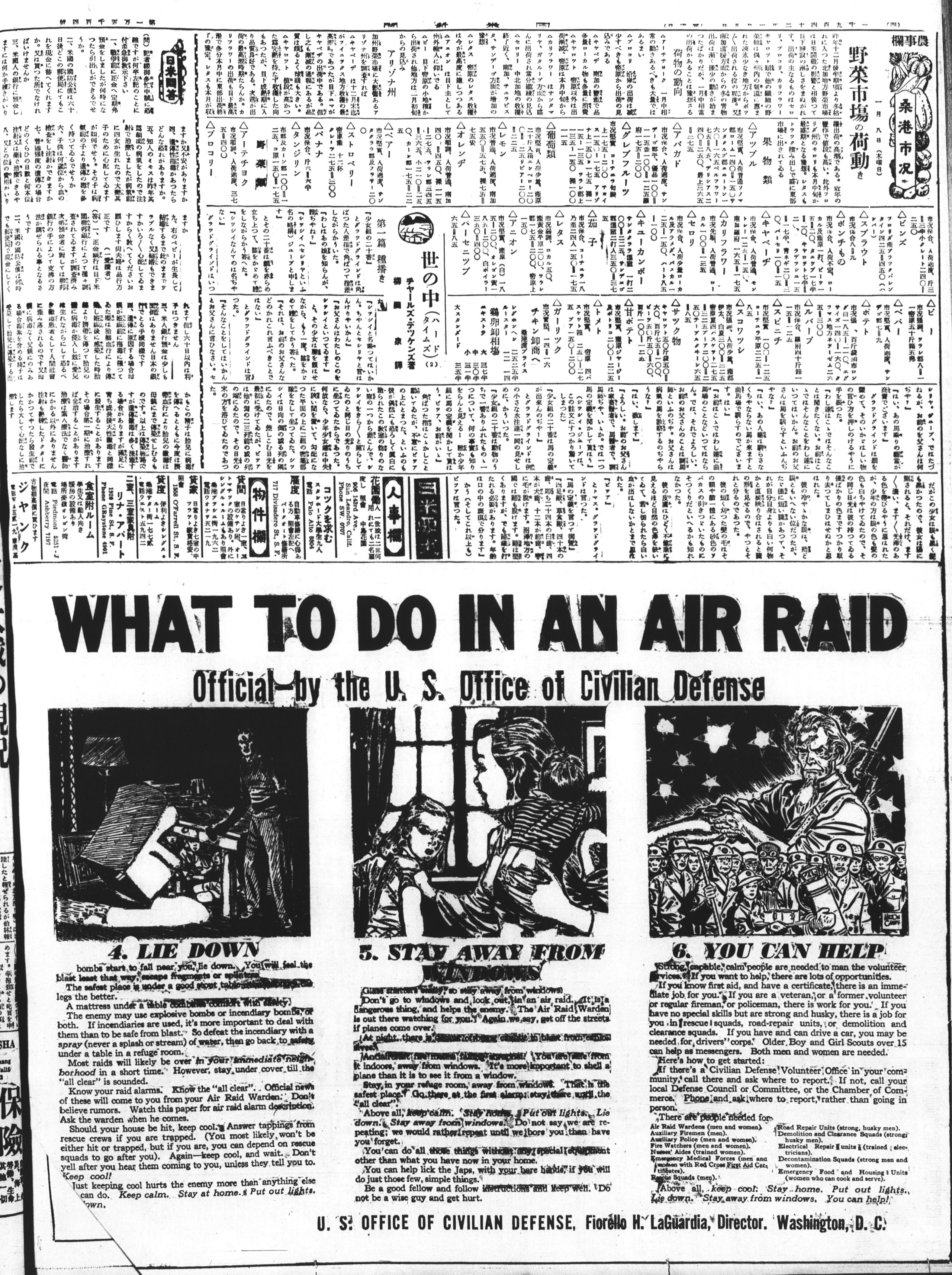
Nichibei Shinbun, January 9, 1942. Hoji Shinbun Digital Collection, Hoover Institution Archives

Nichibei Shinbun, January 9, 1942. Hoji Shinbun Digital Collection, Hoover Institution Archives
Nichibei Shinbun, January 9, 1942. Hoji Shinbun Digital Collection, Hoover Institution Archives
Archival Collections
The majority of material at Hoover related to internment can be found in the archives. In addition to the collections highlighted above, Japanese-language documents like the George Matsusaburo Hibi Writings and the Kotoharu and Sumiye Inouye Papers feature Issei voices.
One of the most lavishly illustrated collections, however, is the Masuo Kitaji Bibles. The two volume bible was the life work of Masuo Kitaji (1897-1973), a Bay Area Japanese American officer in the Salvation Army and an internee at the War Relocation Authority Center in Poston, Arizona. The inside of the bible includes a complete, handwritten Japanese translation interspersed with Kitaji's drawings and notes about his life and Christian vision. A truly remarkable manuscript it provides unexpected insights into the experiences of the Japanese American community.

Masuo Kitaji with bible, Poston, Arizona, September 18, 1944. Masuo Kitaji annotated and illustrated Bibles, Hoover Institution Archives
Masuo Kitaji with bible, Poston, Arizona, September 18, 1944. Masuo Kitaji annotated and illustrated Bibles, Hoover Institution Archives

Masuo Kitaji's Bible: Front Matter, vol. 1, page 6, 1935–1945. Masuo Kitaji annotated and illustrated Bibles, Hoover Institution Archives
Masuo Kitaji's Bible: Front Matter, vol. 1, page 6, 1935–1945. Masuo Kitaji annotated and illustrated Bibles, Hoover Institution Archives

Masuo Kitaji's Bible: The Apocalypse, vol. 1, page 4, 1935–1945. Masuo Kitaji annotated and illustrated Bibles, Hoover Institution Archives
Masuo Kitaji's Bible: The Apocalypse, vol. 1, page 4, 1935–1945. Masuo Kitaji annotated and illustrated Bibles, Hoover Institution Archives
The Hoover Library
“This Institution is not, and must not be, a mere library. But . . . must constantly and dynamically point the road to peace.”
The Hoover Institution Library has extensive material on the Japanese American experience during the internment period of 1942–46. These holdings include original government publications, newsletters and pamphlets produced by Japanese Americans in the relocation camps, and an array of books covering both pro- and anti-internment sentiments. This material greatly enhances research potential for visiting scholars, students and the public. It also allows for a broad understanding of this tragic and life-altering period in American history.
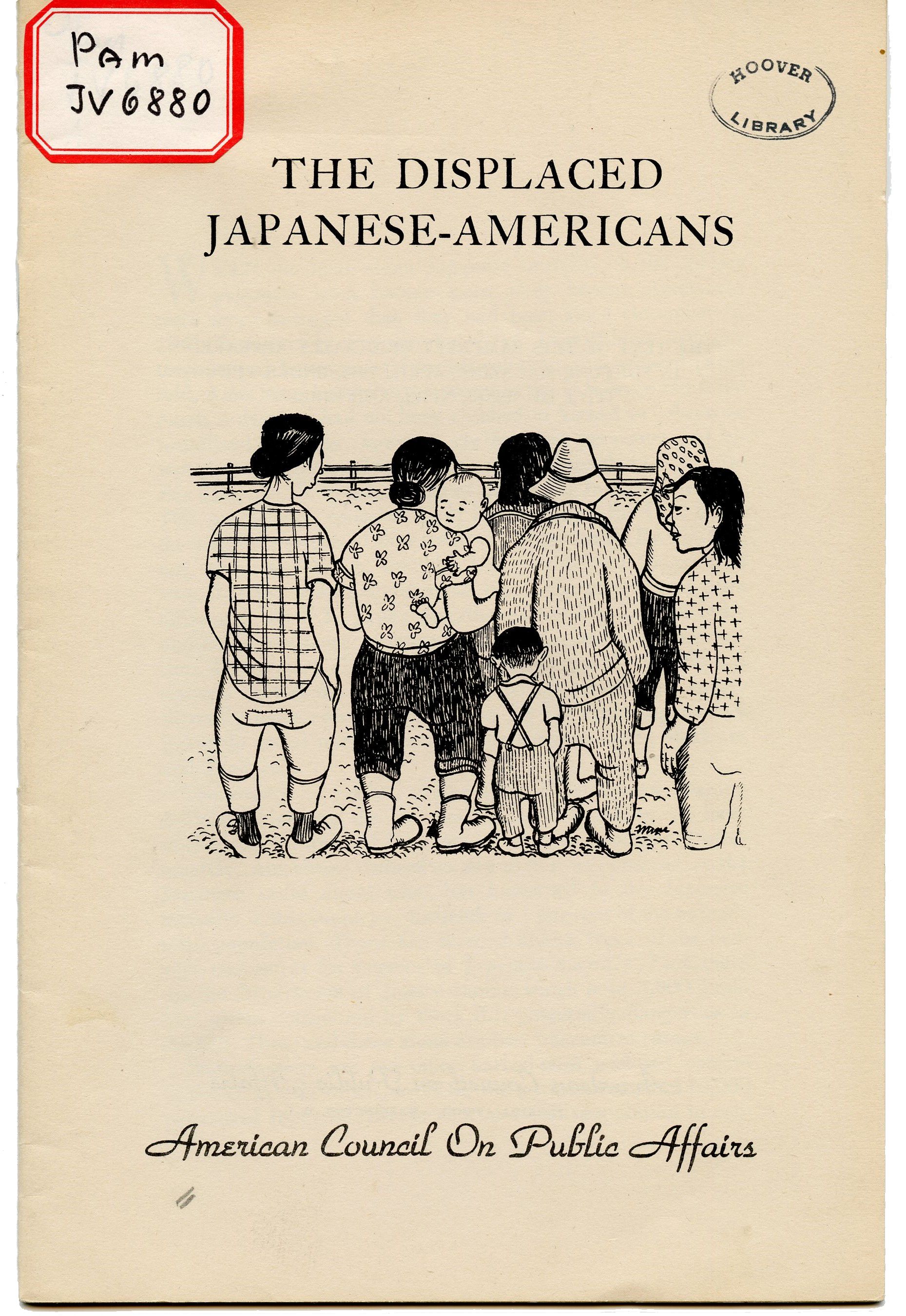
Pamphlet Collection, Hoover Institution Library

Pamphlet Collection, Hoover Institution Library
Pamphlet Collection, Hoover Institution Library
Internment Camp Ephemera
Daily life at the camps could easily become monotonous, with an unknowable future leaving some Japanese Americans few hopes and dreams to strive for. To combat this depressing reality internees and camp administrators tried to normalize routines and activities as best they could.
Along with work, schools, church services and their own community governments, internees were allowed regular recreational activities—including sporting events, theatrical performances, concerts, gardening and art exhibitions. Each camp also created its own newspaper, and the availability of a press meant they were also able to print their own programs and invitations for events.
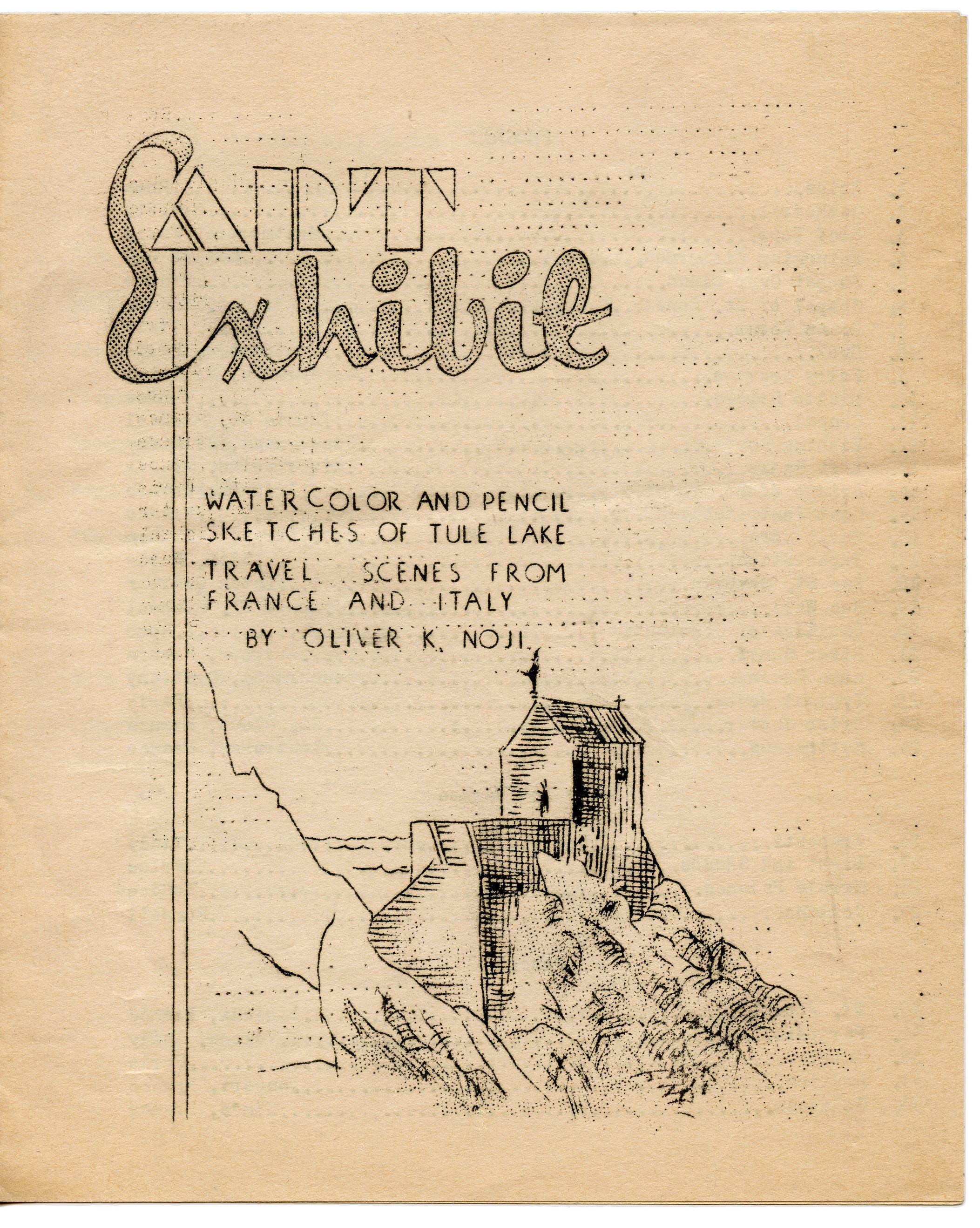
Art Exhibit program, n.d. Hoover Institution Library, D769.8 .A6 T83 F

Art Exhibit program, n.d. Hoover Institution Library, D769.8 .A6 T83 F
Art Exhibit program, n.d. Hoover Institution Library, D769.8 .A6 T83 F

Hand-printed Mothers Day Program and Judo pamphlet from Tule Lake Relocation Center, n.d. Hoover Institution Library
Hand-printed Mothers Day Program and Judo pamphlet from Tule Lake Relocation Center, n.d. Hoover Institution Library
Schools at Internment Camps
Beginning in the fall of 1942, the War Relocation Authority introduced to the camps a system of education known as the"community school," an innovative program for primary and secondary schools crafted by educators at Stanford University.
A copy of the original Proposed Curriculum Procedures for Japanese Relocation Centers can be found in the Hoover Institution Library. It provides a unique glimpse into both the understanding of Americans towards the internees and how the government hoped for the Americanization of those at camp.
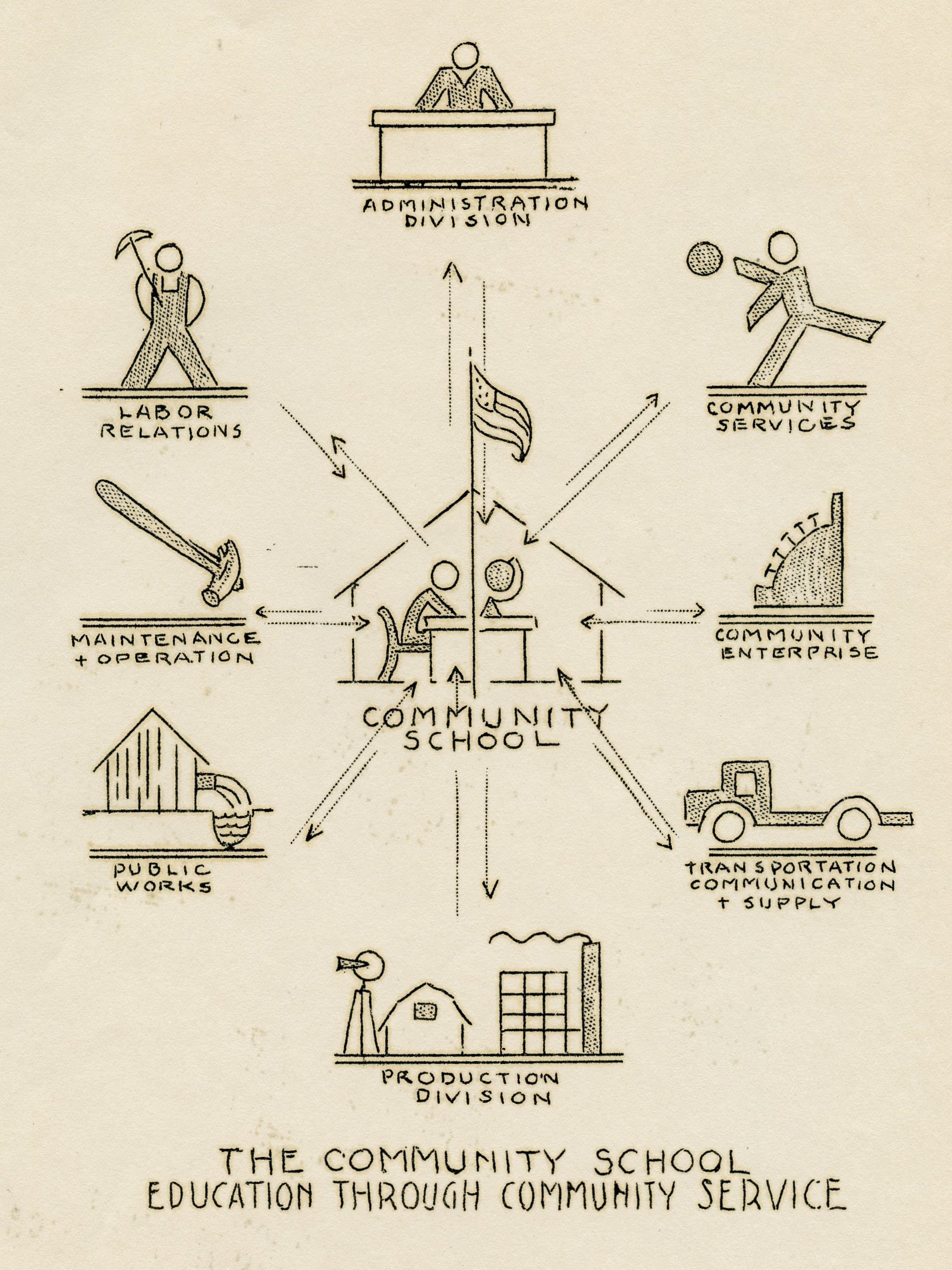
Illustration from Proposed Curriculum Procedures for Japanese Relocation Centers, prepared for the WRA by the Summer Session Students in Education 299b, Stanford University, 1942. Pamphlet Collection, Hoover Institution Library

Illustration from Proposed Curriculum Procedures for Japanese Relocation Centers, prepared for the WRA by the Summer Session Students in Education 299b, Stanford University, 1942. Pamphlet Collection, Hoover Institution Library
Illustration from Proposed Curriculum Procedures for Japanese Relocation Centers, prepared for the WRA by the Summer Session Students in Education 299b, Stanford University, 1942. Pamphlet Collection, Hoover Institution Library

Anonymous prologue from the Proposed Curriculum Procedures for Japanese Relocation Centers, 1942. Pamphlet Collection, Hoover Institution Library
Anonymous prologue from the Proposed Curriculum Procedures for Japanese Relocation Centers, 1942. Pamphlet Collection, Hoover Institution Library

This online exhibit is based on the exhibition, Voices from the Archives: Japanese American Internment, 1942-1946, presented in Hoover Tower on the Stanford University campus, February–October, 2017
The Hoover Institution Library & Archives has placed copies of these works online for educational and research purposes. If you would like to use any of these works, you are responsible for making your own legal assessment and securing any necessary permission. If you have questions about this resource or have concerns about the inclusion of an item, please contact the Hoover exhibits team:Contact Us
For more information about rights and permissions please visit,https://www.hoover.org/library-archives/collections/get-help/right-and-permissions.
© 2022 by the Board of Trustees of Leland Stanford Junior University.
